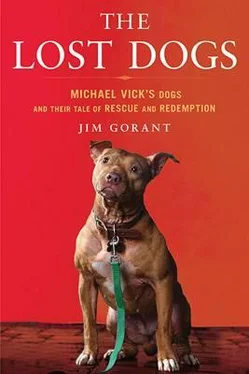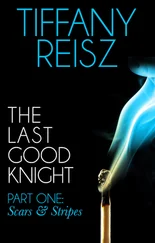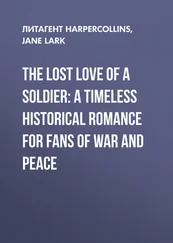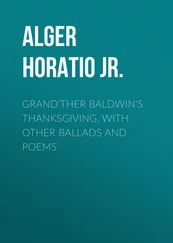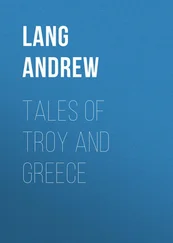But it went beyond that, too. There were broken legs and vertebrae, some severe bone bruising. Most of the dogs, seven out of nine, had skull fractures, at least one of which appeared to be the result of a blow from a hammer. Brownie had reported that he’d once seen a Bad Newz member kill a dog by beating it with a shovel. Vick and friends had not simply eliminated these dogs with a cold efficiency, they’d beaten them first. The revelation added another layer of brutality to the already nasty case.
And then there was one last body that stood out from the rest. It had signs of bruising on all four ankles and all along one side. Its skull was fractured in two places and it had four broken vertebrae. Brownie had said that all of the dogs that didn’t die from being hanged were drowned, except one.
As that dog lay on the ground fighting for air, Quanis Phillips grabbed its front legs and Michael Vick grabbed its hind legs. They swung the dog over their head like a jump rope then slammed it to the ground. The first impact didn’t kill it. So Phillips and Vick slammed it again. The two men kept at it, alternating back and forth, pounding the creature against the ground, until at last, the little red dog was dead.

Most federal indictments are one or two pages long, giving the names of the accused, the crimes they’re being charged with, and little else. On July 17 a federal grand jury heard testimony from Brownie and Oscar Allen, read the affidavits of the imprisoned drug dealers who’d fought dogs with Vick, and heard Melinda Merck’s findings. When Mike Gill was done, the jury accepted an eighteen-page indictment against the four founding members of Bad Newz Kennels. It was part of a carefully planned approach to bring the case to a quick and just end.
The document, known as a walking indictment, laid out the actions and offenses of the accused in painful detail. As much as it was meant to ensure a charge, it was also intended to send a message to the defense: We have a lot of information from multiple sources and we’re not afraid to spell it all out for the jury and the public.
The reaction was swift. Protests sprung up outside the offices of the NFL, the Atlanta Falcons, and Nike. Nike suspended the introduction of a new Michael Vick footwear line and Falcons owner Arthur Blank called a press conference at which he deemed Vick’s actions horrific. Reebok stopped selling Vick jerseys and Upper Deck removed all Vickrelated products from its Web site.

Nine days after the indictment there was a line outside the federal courthouse in Richmond as both protesters and supporters waited to get a seat at the arraignment. For the first time in longer than anyone could remember the court had to funnel onlookers into overflow rooms where they could watch the proceedings live on closed-circuit TV. Those who didn’t make it inside lined the streets outside, chanting and carrying signs.
All four of the accused-Michael Vick, Purnell Peace, Quanis Phillips, and Tony Taylor-pled not guilty to the charges: conspiracy to travel in interstate commerce in aid of unlawful activities and sponsoring a dog in an animal fighting venture. For the first time since late April, when he denied ever being at the house, Vick spoke:
Today in court I pleaded innocent to the allegations made against me. I take the charges very seriously, and I look forward to clearing my good name. I respectfully ask all of you to hold your judgment until all of the facts are shown. Above all, I’d like to say to my mom I’m sorry for what she has had to go through in this most trying of times. It has caused pain to my family and I apologize to my family.
That sounded good but it had little bearing on reality. Legally, Vick had only one hope of “clearing his good name.” He needed the other three guys to tell the same story and stick to it. But any dreams of a united front were soon quashed.
Gill and his associates had never stopped negotiating with Tony Taylor’s lawyer and on July 30, less than two weeks after the indictment, Taylor pled guilty and agreed to cooperate with the investigation. He sat for an extensive interview and then signed a thirteen-page summary of facts in which he detailed the Bad Newz operation, including many of the fights the group hosted and traveled to.
He admitted to the original plan to start the operation, buying the dogs, and having the sheds, the kennel, and eventually the house built. Organizing the fights and training the dogs. Handling the dogs in the ring and placing bets. Killing dogs. The most damning part of Taylor ’s confession was not where he detailed his own role, but where he laid out Vick’s participation. The star quarterback had not only bankrolled the operation, he’d become involved in running it. On numerous occasions when the group tested dogs, Vick was present. He attended fights and bet large sums of money, although he never kept any of the winnings.
The pressure on the remaining three defendants increased dramatically. Lawyers for Peace and Phillips reached out about deals for their clients. They were willing to accept a plea bargain but they didn’t want jail time. They had a point. Although the maximum sentence for the crimes they had been accused of was five years, the government’s official sentencing guidelines, based on factors that included criminal history and cooperation with the prosecution, called for zero to six months in jail. And even with previous records it was not unreasonable to think they could avoid being locked up.
But that didn’t work for Gill. He felt all four men needed to serve time. The negotiations dragged on, until finally on August 17 Peace and Phillips pled guilty, accepted a recommended sentence of twelve to eighteen months, and agreed to testify against Vick. In his post-plea interview, Peace stated that on several occasions he proposed giving away dogs that refused to fight, but Vick had vetoed the suggestion, insisting that the dogs be killed.
Now, only one month after he was officially indicted, Vick was on an island, with an ocean of federally accumulated evidence surrounding him and all three of his former partners implicating him. Still, he appeared determined to go to trial. Perhaps he felt he had too much to lose to give up, but little did he know that Gill had saved one last piece of ammo. In mid-August he let Vick’s attorneys look at a photo that he had acquired. It showed Vick, Peace, Phillips, and Taylor at a dogfight wearing headbands and T-shirts that read Bad Newz Kennels and holding Jane, their grand champion fighter.
Vick’s lawyers knew the impact the photo would have, not just in the courtroom but on TV and in newspapers and magazines around the country. Gill also added pressure by making it known that if the case went forward he’d seek additional charges, including racketeering and tax evasion, crimes that carried even stiffer penalties.
On August 23, Michael Vick signed his plea deal, admitting his guilt and agreeing to pay $928,000 in restitution for the care of the dogs, including any that were deemed worthy of saving after a government team had evaluated them.
Vick submitted the plea to District Court Judge Henry E. Hudson, a hard-line conservative known for meting out harsh sentences and also a dog lover who had a bichon frise at home. Vick appeared before the judge in a plea hearing on August 27. Hudson asked, “Are you entering the plea of guilty to a conspiracy charge because you are in fact guilty?”
Vick replied, “Yes, sir.”
“I totally ask for forgiveness and understanding,” Vick said afterward. “I take full responsibility for my actions. I made a mistake in using bad judgment and making bad decisions. Dogfighting is a terrible thing.” The NFL suspended him indefinitely without pay and Nike terminated his contract.
Читать дальше
